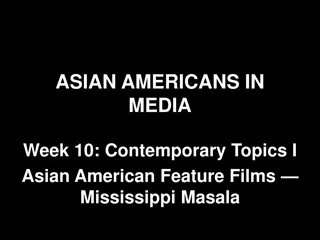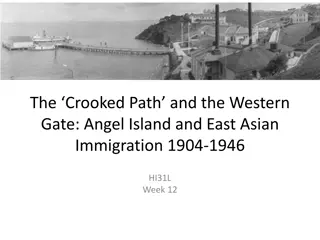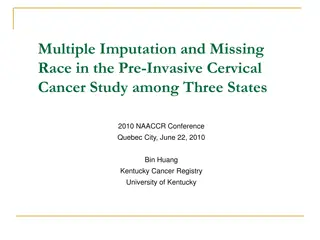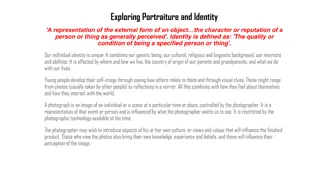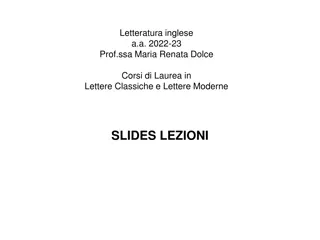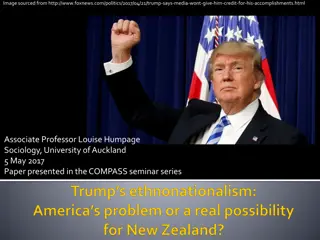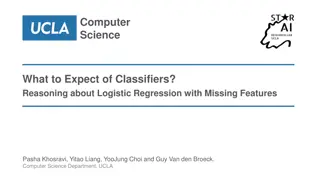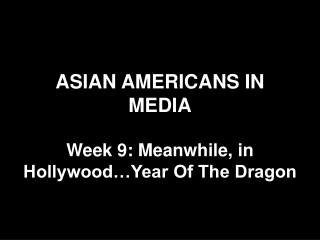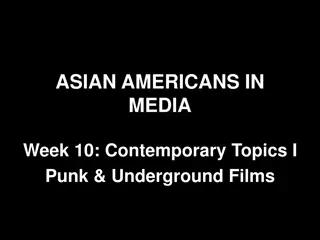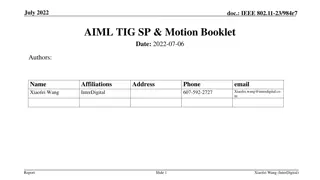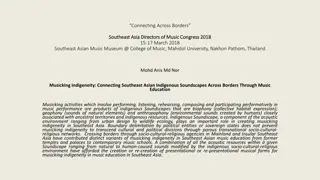Exploring Asian American Identity Through "Chan Is Missing" by Wayne Wang
"Chan Is Missing" (1982) directed by Wayne Wang is a groundbreaking Asian American independent feature film that delves into themes of Asian American identity, hyphenated identity, assimilation, and hybridity. The film, shot on a shoestring budget in San Francisco's Chinatown, showcases the community's inhabitants and their authentic representation. Wayne Wang, a Hong Kong-born filmmaker, has been instrumental in portraying the Asian American experience in his works, transitioning successfully from his early activist days to a more commercial career. Despite not all his films being Asian American-centric, Wang's contributions to cinema have been notable, with a focus on exploring cultural nuances and personal stories.
Download Presentation

Please find below an Image/Link to download the presentation.
The content on the website is provided AS IS for your information and personal use only. It may not be sold, licensed, or shared on other websites without obtaining consent from the author. Download presentation by click this link. If you encounter any issues during the download, it is possible that the publisher has removed the file from their server.
E N D
Presentation Transcript
Notions of Community in Chan Is Missing
Key Terms: Asian American feature films Asian American identity Hyphenated identity / the interval Assimilation / hybridity Asian American subjectivity / Asian American identity
Chan Is Missing (1982) Dir. Wayne Wang Starring Wood Moy, Marc Hayashi, Laureen Chew, Peter Wang
Wayne Wang Born in Hong Kong, 1949, and named after his father s favorite movie star - guess who? Educated in H.K. and the U.S.; studied film and television at California College of Arts and Crafts in Oakland
After graduating from CCA, Wang worked in activist and theater groups in San Francisco s Chinatown. Chan Is Missing is Wang s second film; his first was A Man, a Woman and a Killer (1975), which he made while still in art school. He subsequently made Dim Sum: A Little Bit of Heart (1985), Eat A Bowl of Tea (1989), Joy Luck Club (1993).
Not all of Wang s films are Asian American in theme, e.g. Maid in Manhattan (2002) Wang is one of the few Asian American filmmakers from his generation who successfully made a transition from the artist / activist / scholar mode to a more commercial career
He is still making films in the indiewood mode, recent titles include Smoke and Blue in The Face (both 1995), Center of The World (2001), A Thousand Years of Good Prayers and The Princess of Nebraska (both 2007), Snow Flower and the Secret Fan (2011) Interviews in Moving The Image and Out of The Shadows
Chan Is Missing is one of the first Asian American independent feature films produced outside the studio system. It was shot in B&W 16mm film, produced for less than $25,000. The film was shot on location in San Francisco s Chinatown, featuring its inhabitants, who often play themselves in largely improvised scenes
Title of movie is a reference to the detective series of Charlie Chan, a Chinese immigrant solving crimes in Honolulu Wang flips the script with Chan being the person who is missing and is being searched for
Filmed in English, Chinese (Cantonese and Mandarin), Spanish; early version were not subtitled. Also featured a soundtrack with music from different communities. Based on a true story: the film was dedicated to Wong Cheen, the husband of one of Wang s friends from Taiwan who went missing for several weeks.
Discussion Questions: Which communities are represented in the film? Describe them.
Discussion Questions: Which communities are represented in the film? Describe them. Who is the audience for this film?
Discussion Questions: Which communities are represented in the film? Describe them. Who is the audience for this film? Who is Chan?
Review Race - Socially constructed; Groups that are divided into differences of physical traits, ancestry, and/or social relations Ethnicity Cultural background and heritage; groups distinguished by language, customs, rituals, and national background Exp. Korean and Vietnamese are ethnicities; Asian is a race, Polish and German are ethnicities; white is a race
History of the term Asian American Problematic label America is understood to be the United States and doesn t incorporate South America and other North American countries) Asian typically referred to East Asians, leaving out other Asian identities More of a political designation than a cultural one The term came to be in the late 1960 s during the transformation of racial politics Asians began to recognize and speak to the diversity of their cultural and national traditions Replaces oriental
Key Terms (Cultural) Assimilation When a group s language and/or culture becomes replaced by the dominant society s language and/or culture; usually associated with colonization Hybridity/Heterogeneity Mixture, composed of different parts, fluid Subjectivity self-conscious, how you relate to yourself and your world, identity
The Hyphen Asian American: the hyphen is the line or the space in the middle to designate the shared relationship between two words Asian American: You cannot hear a hyphen. It can also represent the impossibility of a stable position Chan is Missing shows Chinese American heterogeneity and fluidity of Chinese American identity Not just American or Chinese, or a blend of the two, but occupies a third space The destabilization of Chinese American identity leads to the creation of an Asian American subjectivity Focuses on the process of becoming rather than being
Hyphenated Community People who identify as Asian American are divided between being Asian and American, furthermore being Asian can be broken down (Chinese, Laotian, Vietnamese, etc). Chan is Missing seeks to find a voice that is distinctly Asian American and that destabilizes notions of Chinese American Identity. The film constructs an Asian American identity
Who is Chan? Show end scene (1:10:33) The film is in opposition to the Charlie Chan detective movies where the main character, Charlie Chan, exemplified the stereotypical Chinese American identity Chan is never seen in the film Towards the end, it doesn t matter who Chan is, his absence allows the audience to see into the lives of many Asian American characters in the film
The Interval puzzles, I have proposed the metaphor of the doughnut.69 Each character in Chan Is Missing holds a doughnut which contains the possibilities for Chinese American identity in its center; each character glances in the puddle and takes one bite from the doughnut in an attempt to find her/his access to the center. The big doughnut made up of all the little doughnuts-a doughnut akin to the construction of Chinese American identity which the spectator viewing Chan Is Missing is left with-is almost meaningless, almost wholly "hole." Whereas each character fixes Chan Hung in an attempt to fix her/his own identity, the spectator is not allowed to occupy any one of these fixed perspectives but must instead negotiate all of them. Thus each character's bite out of the doughnut-each character's attempt to limit the range of identities for Chan Hung-opens up the interval in the spectator's doughnut, widening the space for spectatorial subjectivity and, by extension, Asian American subjectivity (Peter Feng, 110). While detective films are typically described as if they were jigsaw
The Interval I began to write stories using all the Englishes I grew up with: the English I spoke to my mother, which for lack of a better term might be described as "simple"; the English she used with me, which for lack of a better term might be described as "broken"; my translation of her Chinese, which could certainly be described as "watered down"; and what I imagined to be her translation of her Chinese if she could speak in perfect English, her internal language, and for that I sought to preserve the essence, but neither an English nor a Chinese structure. I wanted to capture what language ability tests can never reveal: her intent, her passion, her imagery, the rhythms of her speech and the nature of her thoughts. -Amy Tan
Chan is Missing Vs Flower Drum Song Flower Drum Song Over-commercialized community San Francisco full of wealthy people Only focuses on Chinese Americans Chan is Missing Encompasses multiple Asian American communities True depiction of San Francisco
Discussion Questions How is Chan represented or described in the film? How does the film construct a positive Asian American identity? How does portrayal of Asian Americans in this film compare to other works we have seen in class? Who is the film catered to?
Bibilography Feng, Peter. "Being Chinese American, Becoming Asian American:" Chan Is Missing"." Cinema Journal (1996): 88-118.








